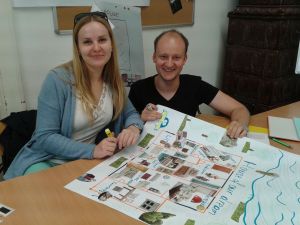This seems like a very easy question to answer, but in giving it some thought over the last few weeks I only began to uncover some of its complexities.
For me I would say that in a good lesson:
- students learn something new
- students are able to use something they have learned
- students’ self-confidence is supported, maintained, or raised
- both students and the teacher have fun
- the time flies
- the teacher feels good about the way the class went
- we try out something new and it works
- the feedback from the students is positive
- students make connections between what they are learning and their ‘real’ lives
- the students ask interested, intelligent, or engaged questions
- students begin to use critical thinking skills
- students contribute their own ideas and opinions
- students support each other and work collaboratively
- we get through most of the material that I had planned to cover
- there is enough time to answer questions and discuss topics which come up
It seems to me that these may be only some of the aspects that could define a successful lesson and some may be more important to some of us than others. What I find intriguing, however, is how to ensure that this happens on a regular basis. What do we need to do to in order to make this part of our everyday teaching experience?
My two main areas of teaching at the moment are classes at the university in which I have a variety of students from different fields of study and at different levels. Three of my classes are on general English and consist of both Austrian and foreign students at B1 level. I have a great deal of freedom in what I cover and how I do it as long as the agreed basics for B1 are present. We had a lot of fun a week ago working on mini-presentations, a sometimes difficult topic in intermediate classes as students may be nervous and read from notes in order to avoid mistakes. In preparation the week before, students were given a worksheet with some ideas about creating their ideal home and were told to bring some photos or pictures to class the following week. They were then given scissors, glue, pens and flipchart paper and asked to create a visual aid for their presentation. The only rule was that this ‘ideal’ home had to be a place where they could all live together. The groups worked with enthusiasm and created wonderful posters which they then presented to the others. It was fascinating to see them stand up and explain their ideas to the rest of the class, speaking freely and enthusiastically about their creations. It seems that some of the reasons this went well was that they had had enough time to work on the posters and what they wanted to say and, in addition, had the support of the others so that they felt confident. It was also completely their own work making it much easier to put into their own words. We all left the classroom feeling that this was a successful lesson and the majority of the points listed above were covered.
Students showing off their work.
My other class at the moment consists of a group of project managers. Here we use a book which is very helpful for me and gives the students the vocabulary they feel they need. One comment that often comes up is that they have the impression that they are not only learning English vocabulary but also learning more about project management, although some of them have been doing it for years. This class is also easy for me to relate to. Although I have never worked specifically as a project manager, having been involved in organizing conferences for teaching associations gives me a great deal of background in getting projects done within a certain period of time. The students also welcome this sort of input as they feel that I truly understand their jobs and what they have to do providing a feeling of rapport in the class. This ease in speaking with each other then leads to lively discussions and the points above are present in these lessons as well.
One thing I have noticed in my reflections is how I feel when I arrive. Those classes I generally look forward to usually go better, whatever the reason may be. It could be that I simply enjoy the company of the students and look forward to spending time with them. I may have prepared a new game or activity I am eager to try out or have one with me that I have used countless times successfully. Or it could be a group in which I feel comfortable enough to simply try out something new on the spot and am confident that it will be a success. Or maybe just noticing the beauty of my surroundings on my way to work. Finding the time to reflect on this while in the midst of the semester of putting exams together, setting homework tasks, grading papers and so on is not always something at the top of our lists. But as teaching is a job that we do not leave behind when we walk out of the classroom, this type of reflection could be exactly what we need to do in order to maintain and enhance the enthusiasm which can help make our jobs a delight to do.
On the way to work



Reblogged this on ΙΔΕΕΣ ΕΚΠΑΙΔΕΥΣΗΣ ΚΑΙ ΑΛΛΑ ΠΟΛΛΑ! Educational ideas for teachers!.
Glad you found this interesting. I think many of us share the same experiences.
It is interesting to note the double role of conferences you mentioned: not only do you learn things at a conference, organizing conferences actually contributes to your teaching!
Naomi
Very nice write-up! The experience of managing conference supported you a lot to become project manager in teaching your diversified groups of learners. I also attended the mega event for English teachers in Birmingham and brought so many applicable techniques back home. Moreover, I got exposure to many celebrities: ELT experts, authors, curriculum designers and teachers from different parts of the world and had a wonderful time in UK.
Thank you Gobinda, I think that we combine many of the things we do and each adds to the other. I am also glad you enjoyed the conference in Birmingham and hope to see you at another such event in the future.